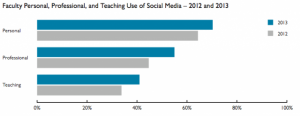As we begin our second week of topic series on stop-and-frisk, I wanted to say a little something more about why we decided to do the series, and how it relates to the overall goal of JustPublics@365, which is to reimagine scholarly communication in the digital era for the public good.
We’re living at a moment in higher education in faculty are increasingly using social media for their personal lives, as well as their work as professional and in the classroom. A new study just released from the Babson Survey Research Group and Pearson finds that 40 percent of faculty members used social media as a teaching tool in 2013.
 (Graphic from Inside Higher Ed)
(Graphic from Inside Higher Ed)
Faculty members’ use of social media has been steadily increasing since the survey was first conducted in 2010, said Jeff Seaman, co-director of the Babson Survey Research Group, in an interview with Inside Higher Ed.
Simultaneously, and for a variety of different reasons, a growing number of faculty want to do interdisciplinary work and they want their work to have a broader impact than simply contributing to the scholarly literature in their sub-field of specialization. However, the reward structure in academia is set against both these possibilities. Zachary Ernst (Associate Professor of Philosophy at the University of Missouri-Columbia), in an eloquent post, “Why I Jumped Off the Ivory Tower,” describes academia as containing “a perverse incentive structure that maintains the status quo, rewards mediocrity, and discourages potentially high-impact, interdisciplinary work.” After detailing an interdisciplinary grant proposal gone horribly awry at his institution, Ernst assesses the situation thusly:
In such an environment, our efforts are channeled into narrow sub-specialties, and we consign our work to a tiny audience. Despite the common talk about the importance of “disruptive research” in the university, there’s no real understanding of what makes something “disruptive”. To disrupt anything requires going outside the normal methods for one’s work, redefining what’s important or interesting, and usually drawing on a wide range of data and methodologies. It almost always requires collaboration, and almost always requires going outside one’s own comfort zone. But in an environment where the senior faculty and administrators have been rewarded throughout their careers for toeing their disciplinary lines, there’s a lot of resistance to change. Some of that resistance is due to outright hostility, but most of it is just the result of a lack of experience and imagination.
While Ernst took a clear eyed view of the limitations of academia and chose to “jump off” the Ivory Tower, we prefer to reimagine it.
The aim of JustPublics@365 is to foster just the kind of “disruptive” work that can foster connections between academics, activists and journalists who are working to address some of the pressing social problems of our time. From where we sit in the heart of New York City, stop-and-frisk is at the top of the list of pressing social problems because of the deleterious effects it has on the democratic life of the city. Stop-and-frisk has also been an issue around which academics, activists and journalists have worked together, across traditional silos and enabled by digital media, in order to end this practice.
So, we offer this series on stop-and-frisk as a kind of case study of how we might reimagine scholarly communication for the public good.


